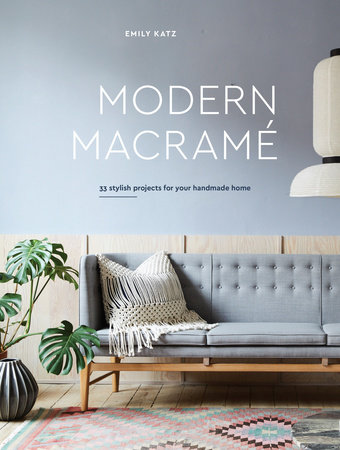Excerpt
Modern Macrame
INTRODUCTION
I learned macramé from my mom.
At sixteen, my mom made macramé plant hangers by hand-knotting cords of brown jute. She sold her creations at a hair salon, frequented by her mother, so that she could buy her first Martin guitar. The fashion trend then was all about hand-knotted beaded belts and ponchos—anything that swung when you wore it. While sifting through photo albums, I discovered that her childhood home was full of macramé. Plants hung in the windows suspended from beaded macramé plant hangers, and knotted owls watched over the family from the wood-paneled walls of the den.
My parents split up when I was nine years old,and my mom moved across the country. We didn’t have much of a relationship while I was growing up; but after turning thirty, I felt like it was time to reconnect. So in 2013, when my boyfriend suggested we visit her while ona trip to the East Coast, I agreed with some trepidation. I didn’t know what I would sayto her. Would we get along? We barely knew each other. But I did know the story about my mom making macramé.
My home in Portland has plants on nearly every surface—more than a hundred of them. Before the trip to see my mom, I had collected a few vintage macramé plant hangers to display my plants in, but I wanted to learn how to make my own. If my mom could teach me how to macramé, my hope was that we could connect over a common interest.
Before settling into my mother’s cozy Connecticut home, we gathered the materials we needed for our afternoon project: cotton cord, a metal ring, and some old beads scavenged from her craft drawer. We stood in her kitchen making plant hangers while my half-sisters baked vegan cookies and my boyfriend sat on the floor serenading us with my mom’s Martin guitar—the same one that she’d bought so many years ago with her earnings from making macramé.
It was a sweet and beautiful moment, one that is forever etched into my memory. After the trip, my boyfriend and I hung the plant hangers in our guest bathroom, and I mostly forgot about macramé. I made a few pieces as gifts for friends, but besides that, I was busy doing other things. During that period, I was working as an art director for a local company and didn’t make a lot of time for crafting.
That fall, a Japanese magazine called
Liniere was in Portland doing a feature on DIY interiors and design. They had discovered our home through my Instagram account and wanted to feature us. Their team wandered around our house, snapping photos and asking through a translator about special details wehad created in our space. How did you make the countertops? What inspired the hand-screen-printed toe kicks for the stairs? Why do you have a mirror over your stove? One woman, Kanae Ishii, renowned for her
Love Customizer craft and DIY books in Japan, asked me where the macramé plant hangers that hung in our bathroom came from.
I began to tell her the story of reconnecting with my mom and how meaningful it was. She listened to the translator and then asked,“But where do we get them?”
At this time, macramé had only recently resurfaced and wasn’t as readily available as it is now. I didn’t know where to send them to find it, so I suggested they check out the flea market or local thrift shops in hopes of finding some fun vintage pieces. After they left, I thought, “What if I taught them myself?” and called to see if they had anytime to come back and learn how to make a macramé plant hanger. Early the next day they arrived back at my home, and I taught my very first macramé workshop to Japanese magazine editors in my living room.
Since then, I’ve gone on to macramé area rugs, ceiling installations, daybeds, headboards, tents, and wedding backdrops. I even fashioned a skeleton costume for Halloween out of macramé. I have taught macramé workshops in Los Angeles, NewYork, London, Copenhagen, and throughout Japan. I’ve grown to appreciate the fact that macramé’s threads run deep through history, from Bedouin caravans to European courts, and from turn-of-the-century sailors’ hammocks to fine Victorian handicrafts. ButI am especially delighted to contribute to its modern renaissance, and am grateful that this medium has inspired a reconnection with my mother that I hadn’t imagined possible.
Nowadays, you can find modern macramé everywhere. It’s the creatively homespun bag on the shoulder of that boho-chic model or your stylish best friend. It holds the plant hanging in the background of that Instagram shot, the fiber art on the wall of a cutting-edge art gallery or boutique hotel. It’s also the textured headboard, the elegant hanging lamp, and the gorgeous patio garlands in this book.
There’s a reason macramé has resurfaced. More and more of us are seeking a bit of warmth, craft, and adornment in the midst of modern life. And macramé—in its clean-yet-dreamy, updated incarnation—is a perfect point of entry into creating a unique, one-of-a-kind, handmade lifestyle, one that is literally at your fingertips. If you have ever wanted to learn macramé but didn’t know where to begin, or even if you are a seasoned knot tier, this book will provide both inspiration and detailed instruction to help guide you on your journey of this beautiful craft.




